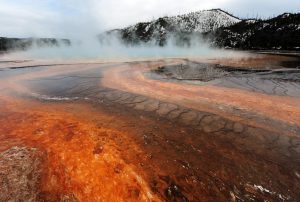Newsweek published a scary-looking headline yesterday: “NASA DISCOVERS MANTLE PLUME ALMOST AS HOT AS YELLOWSTONE SUPERVOLCANO THAT’S MELTING ANTARCTICA FROM BELOW.” It’s a scary idea, right? That heat that drives Yellowstone’s steam vents, boiling hot springs, and explosive geysers is sitting under Antarctica, and scientists didn’t even know about it?? It has certainly generated some discussion in our department. But don’t panic yet – scientists have been aware for decades of volcanic activity under West Antarctica, and it’s not nearly as hot as the article would like you to think.
The Newsweek article goes on to explain some of the details of a study that was published last month in the Journal of Geophysical Research: Solid Earth (Seroussi et al., 2017). The study used an ice flow model to try to capture the ice dynamics of West Antarctica as accurately as possible, and then used that model to glean some details about how much heat is being released through the ground (that’s called the “geothermal heat flux”) under the West Antarctic Ice Sheet.
What they found is both unsurprising and important. West Antarctica has a much higher heat flux than surrounding areas, because there is hot mantle rock near the surface driving volcanic activity. That’s hardly a secret in glaciology – for example, it was an important consideration in this study by J. Weertman from 1982. Ice flow models of the area have always had to take into account this warming of the base of the ice to accurately model how easily the ice slides and deforms. What this new paper brings us is some more accuracy to use in our models. It gives us more reliable numbers for just how much heating there is and where it is concentrated, so we can make our ice flow models more accurate. Specifically, the authors calculate that the mantle plume is bringing up to 150 milliwatts of heat per square meter to the base of the West Antarctic Ice Sheet, with isolated areas perhaps getting to 180 milliwatts of heat per square meter.
What this article really gives us is a lesson in science communication and how a story can be easily hyped into something much scarier than it is. The Newsweek article uses two images – the first is of part of West Antarctica (Mari Byrd Land, by NASA/Michael Studinger), and the second of the Grand Prismatic Hot Spring in Yellowstone (by Mark Ralston/AFP/Getty Images):
Putting these two images next to each other evokes some strong reactions. If you put ice on top of that hot spring, it’s going to melt – FAST!! The problem is, the heat flux numbers in Seroussi et al. (2017) don’t come anywhere near the heat flux you’d get at Grand Prismatic Spring. According to the USGS, some of Yellowstone’s thermal areas have heat fluxes of over 100 watts per square meter. Seroussi et al. (2017) measured heat flux under West Antarctica in milliwatts – 1000x smaller than a watt. So that picture of Grand Prismatic Spring probably represents a heat flux of something like 100,000 milliwatts per square meter, while the ice in the other picture is sitting on top of 150 milliwatts per square meter.
Now, you could argue averages with me – even if 150 milliwatts per square meter is the average, there could be some areas that are much hotter, just like in Yellowstone. The evidence really isn’t there for that, however. If a region under the ice did have a heat flux of 100,000 milliwatts per square meter, it would be hard to miss. I haven’t built the models, but we would expect obvious aberrations in ice flow and water discharge in the area, which isn’t consistent with our observations. It’s more likely that it’s a bit warmer in some areas and a bit cooler in others, but we aren’t going to find Grand Prismatic Spring under Antarctica.
Furthermore, while this is a new study that uses an impressive set of models to show that a mantle plume is likely causing the heat flux, it is hardly a new discovery that the ground is relatively warm under West Antarctica. Heat flux is already included in the models, and scientists are always working to refine their estimates and increase model accuracy. But regardless of the discovery, it’s always important to read scientific news articles critically, to understand if their main points are scientifically reasonable, or if there’s a spin to get you to click on the article. In this case, it’s the latter.




